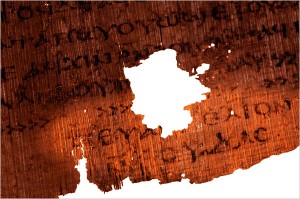One of the things that often affects discussions about Biblical manuscripts from antiquity is assumptions about how they were made. For example, you regularly hear NT scholars say things like ‘Luke’s Gospel contains about the maximum number of Greek characters one could get on a single papyrus roll’. While this may or may not be true, it was always possible to glue on another roll and keep writing. The issue of space only becomes important if: 1) you’re dealing with a poor person who can’t afford the cost of another bookroll and has no other ones to recycle, or 2) the existing project is already so huge and bulky adding another roll or partial roll is not really a viable option.
Helping us immensely with such calculations is the work of classics scholar William A. Johnson. I have reviewed previously two of his works (one which he edited called Ancient Literacies, and his stand alone monograph on books and the book trade) on this blog, but here we will be interacting with an earlier quite technical monograph of his entitled Bookrolls and Scribes in Oxyrhynchus (Toronto U. Press, 2004). This monograph is for those who can actually read ancient Greek and involves lots of technical details and charts. It either is, or isn’t, good bedtime reading, depending on whether you want to stay awake or go to sleep. Don’t wait for the movie version. Nevertheless, this monograph is full of very important and fresh information because Johnson has a good thorough, keen analytical mind (and I say this even though he got a higher degree from Duke :). Johnson seeks to interject some systematic thinking into what has often degenerated into generalizations based on too small a sample size— I am talking about the generalizations papyrologists sometimes make about the production of bookrolls and the methods of scribes.
In regard to his method, Johnson is focusing on some 400 fragments or whole bookrolls from Oxyrhychus in Egypt dating from between the first and third centuries A.D. He has deliberately chosen manuscripts that have texts which are not ‘lost’, but rather texts which we have plenty of later, including medieval, examples of. This eliminates a lot of guess work about the contents of the documents and allows one to draw more conclusions about the form and function and aesthetics of ancient bookrolls. From the outset, Johnson is emphatic that it is a mistake to make generalizations about bookrolls based on study of later codices. This of course is directly relevant to the discussion about ancient NT manuscripts, though Johnson’s focus is on texts of the Greek and Latin classics. For example, on pp. 85-86 he stress that bookrolls are written in columns, usually dual columns on each segment, codices are written on pages. The logistics of writing, and how much one can get per segment differ between these two formats. Bookrolls have the advantage of being easier to assemble. Codexes require lots of cutting, sewing, quires etc. Their advantage is protecting the contents better and have an easier uniform lay out, easier for the reader to follow. But, it was always possible to glue on what we would call cover sheets for the beginning and ends of a bookroll to protect the extremities of the roll, though it is not clear how often this would be done. What we do know is that the scribe was quite capable of using his knife, cutting a piece off another blank bookroll, adding it to the existing roll, and finishing off a writing project. He was not required to simply mindlessly glue on another whole roll even if he was only going to use a little of it. And this brings to light another important point. Scribes did not have to fill up unused portions of a roll, they could simply cut off the excess and be done with a project. When a scribe assembles together say several speeches or several letters or several small collections of things into a single it is because he wants them assembled together in a particular bookroll. He is not simply trying to use up left over space. This observation becomes of importance when we begin to think about the collecting of say Paul’s letters into a single collection, or say the four earliest Gospels. In the posts that follow, I will be giving some information that should guide us in the way we think about the composing of the NT bookrolls. What we should not assume without evidence, is that very early on, NT documents were assembled as codices. The bookroll was by far the most common delivery system for ancient information, and the production of a codex was difficult and time consuming, not to mention potentially expensive. While of course we have clear evidence of NT documents written on codices in the 4th century and later when Christianity became a ‘legal’ religion, we should not assume a lot of that sort of production at an earlier date.













